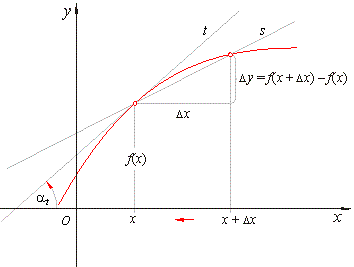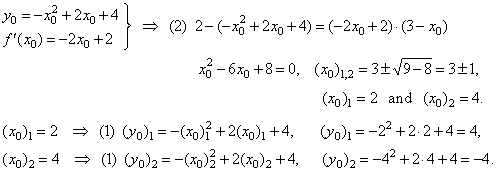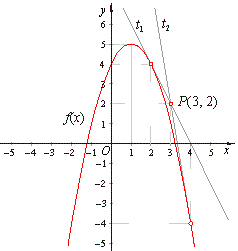|
| Differential
calculus |
|
|
|
|
Differential
Calculus
- Derivatives and differentials |
 The derivative of a
function
The derivative of a
function |
|
Definition of the derivative of a function |
|
Tangent to
a curve |
 Determining
the lines tangent to the graph of a function from a point outside the
function
Determining
the lines tangent to the graph of a function from a point outside the
function |
| Determining
the lines tangent to the graph of a function from a point outside the
function, example |
|
|
|
|
|
|
|
|
| The
derivative of a function |
|
The
slope or the gradient of the secant line joining points (x,
f (x)) and (x
+ Dx,
f (x + Dx))
given by |

|
| is
called the difference quotient, and
represents the average rate of change of the function y
= f (x). |

|
|
Note
that in the above equation x
is the given fixed point and the only variable quantity is the
distance
|
| increment,
Dx. |
|
|
|
Definition of the derivative of a function |
|
As
the distance
Dx
gets smaller, the average rate of change
becomes more accurate, that is the secant line becomes
more and more like the tangent line of the curve at the point
(x,
f (x)),
as shows the figure above.
|
| Therefore,
the limit of the difference quotient as Dx
®
0,
that
equals
the slope of the line tangent to the curve at
the
point (x,
f (x)),
|
 |
|
represents the instantaneous rate of change of the function
with respect to x,
or when written as
|
|
|
|
where
Dx
is substituted with h,
is
called the derivative of a function
f
at a given point x.
|
|
Geometrically,
the derivative is the slope m
(gradient) of the tangent at the point (x,
y) to the curve y
= f (x).
|
| There
are other common notations for the derivative like, |
 |
|
|
|
|
|
Determining the lines tangent to the graph of a function from a point outside the
function
|
|
Lines
tangent to the graph of a function y
= f (x)
from a given point (x1,
y1)
outside the function are defined
by two
points they pass through, the given point
(x1,
y1)
and the point of tangency (x0,
y0).
|
|
To
find the coordinates x0
and y0
of the points of tangency we should solve the following two
equations,
|
|
(1) y0
=
f
(x0) |
|
(2) y1
-
y0
=
f
'
(x0) · (x1
-
x0)
|
|
as
the system of the two equations with the two unknowns x0
and y0.
|
|
The
first equation states that the point of tangency must lie on the
given function while, at the same time, its coordinates
x0
and y0
must satisfy the equation of the tangent line (2),
since the point of tangency is the common point of the
tangent
and the curve.
|
|
Thus
for example, if given is the quadratic function
f (x)
= ax2
+ bx
+ c
and
the point P1(x1,
y1)
then, applying
the above system of equations we can calculate
the coordinates of the points of tangency
P0(x0,
y0)
directly from the formulas,
|
|
|
|
|
Example: Find equations of the lines tangent
to the function f
(x)
= -
x2
+ 2x
+ 4
drawn
from the point
(3,
2).
|
|
|
| Solution: To
find the coordinates x0
and y0
of the points of tangency we should solve the system of equations.
Substitute given quantities, the point (3,
2)
and f
(x)
= -
x2
+ 2x
+ 4
into equations, |
|

|
|
Let calculate the slope
f
'
(x0)
of the tangent line, the equation
(2).
|

|
| Then
substitute the slope and the y0
into second equation to get the points of tangency, |

|
| Therefore, the points of tangency
are (2,
4)
and (4, -4). |
| To
write the equations of tangents t1
and t2
we calculate their
slopes m1
and m2
from |
| f
'
(x0)
= -
2x0
+ 2. |
| Thus,
m1
=
f
'
(2)
= -
2
· 2
+ 2
= -
2,
m1
= -
2, |
|
and m2
=
f
'
(4)
= -
2
· 4
+ 2
= -
6,
m2
= -
6. |
| The
tangent
t1
through the point (2,
4)
and m1
= -
2, and
the
tangent
t2
through the point (4, -4)
and m2
= -
6, |
| t1 ::
y
= -
2x
+ 8
and
t2 ::
y
= -
6x
+ 20. |
|
 |
|
|
Check
the coordinates of the points of tangency by plugging the
corresponding parameters into the above
formulas.
|
|